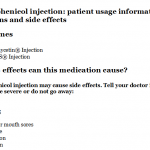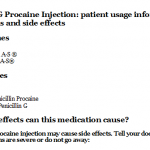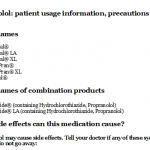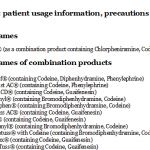
Metaproterenol: patient usage information, precautions and side effects
Tuesday, May 30, 2017 by Gregory Van Dyke
http://www.naturalnewsreference.com/2017-05-30-metaproterenol-patient-usage-information-precautions-and-side-effects.html
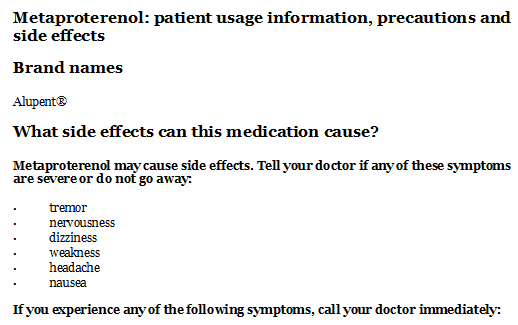
Metaproterenol: patient usage information, precautions and side effects
Brand names
Alupent®
What side effects can this medication cause?
Metaproterenol may cause side effects. Tell your doctor if any of these symptoms are severe or do not go away:
-
tremor
-
nervousness
-
dizziness
-
weakness
-
headache
-
nausea
If you experience any of the following symptoms, call your doctor immediately:
-
increased difficulty breathing
-
rapid or increased heart rate
-
irregular heartbeat
-
chest pain or discomfort
If you experience a serious side effect, you or your doctor may send a report to the Food and Drug Administration’s (FDA) MedWatch Adverse Event Reporting program online (http://www.fda.gov/Safety/MedWatch) or by phone (1-800-332-1088).
Why is this medication prescribed?
Metaproterenol is used to prevent and treat wheezing, shortness of breath, coughing, and chest tightness caused by asthma, chronic bronchitis, emphysema, and other lung diseases. It relaxes and opens air passages in the lungs, making it easier to breathe.
How should this medicine be used?
Metaproterenol comes as tablets and syrup to take by mouth and as a solution to inhale by mouth. It usually is used by oral inhalation every 4 hours to relieve symptoms or 3 to 4 times a day to prevent symptoms or by mouth three or four times a day. Follow the directions on your prescription label carefully, and ask your doctor or pharmacist to explain any part you do not understand. Use metaproterenol exactly as directed. Do not use more or less of it or use it more often than prescribed by your doctor.
Metaproterenol controls symptoms of asthma and other lung diseases but does not cure them. Continue to use metaproterenol even if you feel well. Do not stop using metaproterenol without talking to your doctor.
Other uses for this medicine
This medication is sometimes prescribed for other uses; ask your doctor or pharmacist for more information.
What special precautions should I follow?
Before using metaproterenol,
-
tell your doctor and pharmacist if you are allergic to metaproterenol or any other drugs.
-
tell your doctor and pharmacist what prescription medications you are taking, especially atenolol (Tenormin); carteolol (Cartrol); labetalol (Normodyne, Trandate); metoprolol (Lopressor); nadolol (Corgard); phenelzine (Nardil); propranolol (Inderal); sotalol (Betapace); theophylline (Theo-Dur); timolol (Blocadren); tranylcypromine (Parnate); other medications for asthma, heart disease, or depression.
-
tell your doctor and pharmacist what nonprescription medications and vitamins you are taking, including ephedrine, phenylephrine, phenylpropanolamine, or pseudoephedrine. Many nonprescription products contain these drugs (e.g., diet pills and medications for colds and asthma), so check labels carefully. Do not take any of these medications without talking to your doctor (even if you never had a problem taking them before).
-
tell your doctor if you have or have ever had irregular heartbeat, increased heart rate, glaucoma, heart disease, high blood pressure, an overactive thyroid gland, diabetes, or seizures.
-
tell your doctor if you are pregnant, plan to become pregnant, or are breast-feeding. If you become pregnant while using metaproterenol, call your doctor.
-
if you are having surgery, including dental surgery, tell the doctor or dentist that you are using metaproterenol.
What should I do if I forget a dose?
Use the missed dose as soon as you remember it. However, if it is almost time for the next dose, skip the missed dose and continue your regular dosing schedule. Do not use a double dose to make up for a missed one.
What should I know about storage and disposal of this medication?
Keep this medication in the container it came in, tightly closed, and out of reach of children. Store it at room temperature and away from excess heat and moisture (not in the bathroom). Do not use the solution if it is pink, yellow, or darker than usual or if it has floating particles.
Unneeded medications should be disposed of in special ways to ensure that pets, children, and other people cannot consume them. However, you should not flush this medication down the toilet. Instead, the best way to dispose of your medication is through a medicine take-back program. Talk to your pharmacist or contact your local garbage/recycling department to learn about take-back programs in your community. See the FDA’s Safe Disposal of Medicines website (http://goo.gl/c4Rm4p) for more information if you do not have access to a take-back program.
In case of emergency/overdose
In case of overdose, call your local poison control center at 1-800-222-1222. If the victim has collapsed or is not breathing, call local emergency services at 911.
What other information should I know?
Keep all appointments with your doctor.
Do not let anyone else use your medication. Ask your pharmacist any questions you have about refilling your prescription.
It is important for you to keep a written list of all of the prescription and nonprescription (over-the-counter) medicines you are taking, as well as any products such as vitamins, minerals, or other dietary supplements. You should bring this list with you each time you visit a doctor or if you are admitted to a hospital. It is also important information to carry with you in case of emergencies.
Why is this medication prescribed?
How should this medicine be used?
What special precautions should I follow?
What should I do if I forget a dose?
What side effects can this medication cause?
What should I know about storage and disposal of this medication?
Tagged Under: Tags: chemical medicine, medication, Pharma, Prescription Medicine

